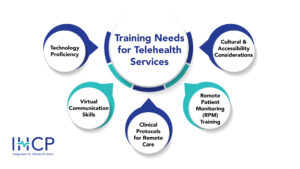Introduction: The Growth of Telemedicine in Healthcare Staffing
Over the past decade, telemedicine has transformed from a niche service into a mainstream mode of healthcare delivery. Advancements in technology, increased broadband access, and a growing demand for convenient care options have fueled its expansion. The COVID-19 pandemic acted as a major accelerator, pushing providers to adopt telehealth at unprecedented rates to maintain continuity of care while minimizing physical contact.
Today, telemedicine is no longer an optional supplement—it is a critical component of modern healthcare strategy. From primary care and mental health consultations to chronic disease management and post-surgical follow-ups, virtual care is redefining how and where patients engage with providers. This shift has significant implications for healthcare staffing agency models, medical staffing solutions, workforce training, and compliance strategies.
Shifting Roles and Responsibilities in Virtual Healthcare Staffing
Telemedicine has reshaped not only where care happens but also who delivers it and how. Traditional, in-person roles are evolving to meet the demands of a digital-first healthcare environment.
- Expanded Scope for Clinicians
Physicians, nurse practitioners, and physician assistants now conduct more virtual visits, requiring strong communication skills and comfort with remote diagnostic tools. In many cases, clinicians are managing larger patient panels due to the efficiency of virtual care. This shift underscores the importance of healthcare workforce solutions to ensure sustainable patient-to-provider ratios. - Rise of Telehealth Support Roles
Healthcare organizations are adding new positions such as telehealth coordinators, virtual medical assistants, and remote patient monitoring (RPM) specialists. These professionals handle scheduling, tech support, data collection, and pre-visit patient education —roles now frequently supported by hospital staffing services and specialized recruitment teams. - Multidisciplinary Collaboration
Telemedicine facilitates greater collaboration between specialties, often enabling same-day consults between primary care providers and specialists, regardless of geography. This has created a need for streamlined communication workflows and shared digital records—areas where healthcare recruitment consulting and executive placement firms help organizations adapt. - Flexible Staffing Models
The virtual nature of telemedicine allows providers to operate across wider geographic areas. This flexibility supports part-time, contract, and locum tenens arrangements, helping organizations address healthcare staffing challenges in underserved regions. Many best healthcare staffing agencies are now offering hybrid models that blend in-person and virtual care professionals.
Training Needs for Telehealth Services in Medical Staffing
The expansion of telemedicine requires targeted training to ensure clinical quality, patient satisfaction, and compliance.
- Technology Proficiency
Providers must be proficient in using telehealth platforms, integrating electronic health records (EHRs), and troubleshooting basic technical issues. Training should also cover secure data handling during virtual interactions. —key aspects of telemedicine staffing solutions and digital health workforce trends. - Virtual Communication Skills
Effective bedside manner must be adapted for the screen. Clinicians need to learn techniques for building rapport, reading non-verbal cues, and ensuring patients feel heard and understood during virtual visits. - Clinical Protocols for Remote Care
Protocols for patient triage, escalation, and follow-up must be updated to fit virtual care models. Training should include best practices for remote diagnosis, documentation, and continuity of care. - Remote Patient Monitoring (RPM) Training
As RPM becomes more common, staff must learn to interpret incoming data from wearable devices, communicate alerts, and integrate findings into care plans. This is where virtual healthcare staffing models and operational excellence consulting intersect—ensuring staff are ready for new digital-first workflows. - Cultural and Accessibility Considerations
Telemedicine training should address language barriers, digital literacy, and accessibility for patients with disabilities to ensure equitable care delivery.
Regulatory and Compliance Considerations in Telemedicine Staffing
Telemedicine operates in a rapidly evolving regulatory environment. Healthcare organizations must navigate complex compliance requirements to operate effectively and avoid legal pitfalls.
- Licensing and Cross-State Practice
Many telehealth services require providers to be licensed in the state where the patient is located. Organizations must monitor licensure status and stay updated on evolving interstate compacts—a critical service offered by healthcare consulting firms. - Reimbursement Policies
Telemedicine reimbursement rules vary by payer and jurisdiction. Billing teams must stay informed on coverage changes, especially as temporary pandemic-era flexibilities expire. - HIPAA and Data Privacy
Virtual care must comply with HIPAA and other data privacy regulations. Secure video platforms, encrypted communication channels, and strict access controls are essential to hospital staffing services and digital operations. - Informed Consent Requirements
Some states require specific patient consent for telehealth services. Staff should be trained to obtain and document consent in compliance with applicable laws. - Malpractice Coverage
Telemedicine may require adjustments to malpractice insurance policies, particularly when expanding into new states or offering services across borders.
Conclusion: Adapting to a Virtual Care Staffing Model
Telemedicine has redefined healthcare delivery, presenting both opportunities and challenges for staffing models. By expanding clinician roles, introducing new support positions, and enabling flexible work arrangements, telehealth offers a path to more efficient, accessible care. However, this shift demands comprehensive training, thoughtful regulatory navigation, and robust technology infrastructure.
Healthcare organizations that proactively adapt to these changes will not only improve patient access but also enhance workforce satisfaction and retention. The future of healthcare staffing solutions will increasingly blend virtual and in-person roles—and those prepared to embrace the hybrid model will lead the way in delivering high-quality, patient-centered care.
At IHCP, we help healthcare organizations adapt their staffing strategies for the realities of modern care delivery, including the rise of telemedicine. From workforce planning and training programs to compliance guidance, we provide medical staffing solutions that position your team for success in a digital-first healthcare environment.
FAQs: Telemedicine Staffing Solutions and Healthcare Workforce
- How has telemedicine changed healthcare staffing needs?
Telemedicine has expanded the need for tech-savvy clinicians, introduced new support roles like telehealth coordinators and remote patient monitoring specialists, and created opportunities for flexible, location-independent staffing models through healthcare workforce solutions. - Do clinicians need special training to provide telehealth services?
Yes. Training should cover telehealth platform use, virtual communication skills, updated clinical protocols for remote care, and HIPAA-compliant data handling. Providers must also adapt their bedside manner for the screen. - Can telemedicine help reduce staffing shortages?
Absolutely. By enabling providers to care for patients remotely, telemedicine allows healthcare organizations to expand coverage, fill gaps in underserved areas, and utilize part-time or contract clinicians more effectively—making emergency healthcare staffing more efficient. - What compliance challenges should healthcare organizations consider?
Key issues include cross-state licensure requirements, evolving reimbursement policies, HIPAA compliance, informed consent documentation, and ensuring malpractice coverage extends to telehealth services. - Does telemedicine improve patient access to care?
Yes. Telemedicine reduces travel barriers, increases appointment availability, and offers more flexible scheduling—benefiting rural, mobility-impaired, and time-constrained patients in particular.







